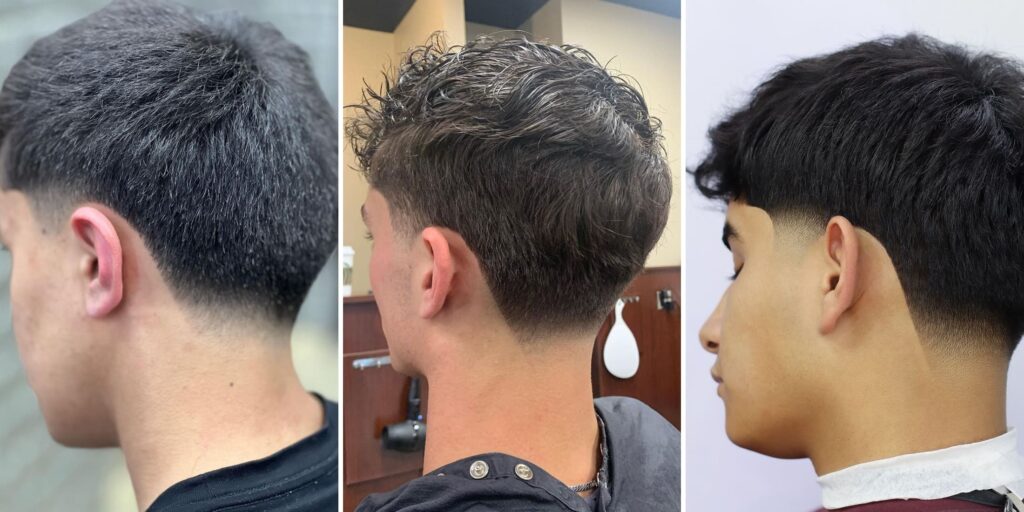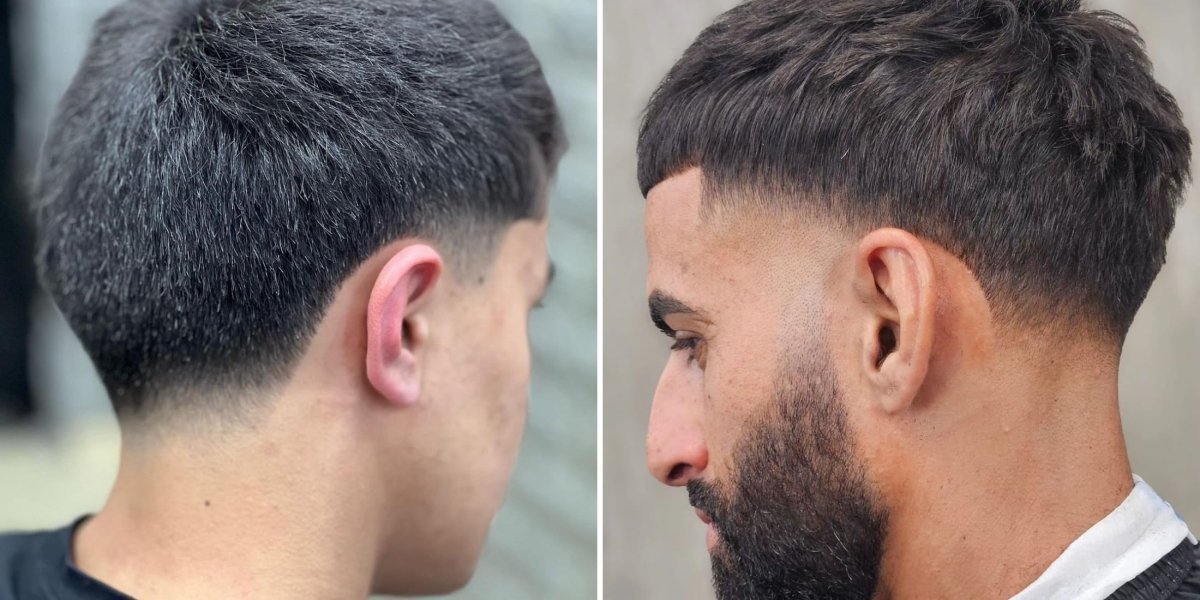When it comes to choosing the perfect haircut, do you know the key differences between a low taper vs high taper? These popular styles each offer unique benefits and aesthetics, catering to different face shapes, hair types, and personal styles.
Are you aiming for a subtle, professional look or a bold, modern edge? This guide will help you understand low and high tapers, ensuring you make the best choice for your lifestyle and always look sharp. Ready to find your perfect taper? Let’s dive in!
What Is A Low Taper
A low taper haircut is a stylish and subtle way to add some neatness and structure to your hair. In this cut, the hair gradually gets shorter as it moves down toward the neckline, starting at a point lower on the head compared to other taper styles. This creates a smooth, blended look that’s not too dramatic but still sharp and clean.
What Does A Low Taper Look Like?

Pros and Cons
Pros:
- Versatile: Works well with various hairstyles.
- Subtle: Provides a clean look without being too bold.
- Low Maintenance: Easier to maintain compared to higher tapers.
- Professional: Ideal for both casual and formal settings.
Cons:
- Less Dramatic: Might not stand out as much as a high taper.
- Growth Visibility: Regrowth can become noticeable faster, requiring more frequent touch-ups.
In the low taper vs high taper debate, the low taper is your go-to for a more understated, adaptable, and easy-to-manage look. It’s a great choice if you want something that’s stylish yet doesn’t demand too much attention.
What Is A High Taper Haircut
A high taper haircut is a bolder and more defined variation of the classic taper. In this style, the tapering effect starts higher up on the head, around the temples or even higher. This creates a striking contrast between the longer hair on top and the shorter sides and back, resulting in a sharp, edgy look that stands out.
What Does A High Taper Look Like?

Pros and Cons
Pros:
- Bold Look: Creates a sharp and noticeable contrast.
- Modern Style: Perfect for contemporary and trendy hairstyles.
- Versatility: Can be paired with a variety of top styles, from pompadours to faux hawks.
- Cool Factor: Adds an edgy and stylish vibe to your appearance.
Cons:
- Higher Maintenance: Requires more frequent trips to the barber to maintain the crisp look.
- Not for Everyone: Might be too dramatic for some professional or conservative settings.
- Face Shape Sensitivity: Can emphasize certain facial features more than others.
When comparing the low taper vs high taper, the high taper haircut is your choice for a modern, eye-catching style that demands attention. It’s perfect for those who love to experiment with their look and aren’t afraid to stand out.
Low Taper vs High Taper: How To Choose The Taper For You
Deciding between a low taper vs high taper can be tricky. Use this guide to choose the perfect taper style based on your personal style, face shape, hair type, and lifestyle.
Personal Style
Your personal style plays a significant role in choosing the right taper.
- Classic and Subtle: If you prefer a timeless and understated look, a low taper is ideal. It’s versatile and blends seamlessly with traditional styles.
- Bold and Modern: For those who love to make a statement and keep up with the latest trends, a high taper is the way to go. It adds a sharp, edgy vibe to your appearance.
- Professional: A low taper is typically more suitable for professional settings, offering a neat and polished look without being too dramatic.
Face Shape
Your face shape can help determine which taper style will enhance your features best.
- Round Faces: A low taper adds definition and structure, making the face appear longer and more angular.
- Square Faces: Both low and high tapers work well, but a low taper can soften the strong jawline, while a high taper emphasizes it.
- Oval Faces: Lucky you! Both low and high tapers complement oval faces, giving you the freedom to choose based on your personal preference.
- Heart-shaped Faces: A high taper adds width to the upper part of the face, balancing a narrower chin.
Hair Type
Your hair type and texture also influence which taper style will look best.
- Straight Hair: A low taper highlights clean lines and looks smooth and polished. High tapers work well too, especially if you’re aiming for a modern style.
- Wavy Hair: Both tapers work well, but a low taper helps manage waves while keeping the look soft. A high taper showcases the natural texture beautifully.
- Curly Hair: A high taper can highlight curls on top while keeping the sides neat. A low taper offers a more gradual transition, making it easier to manage.
- Thick Hair: High tapers are great for thick hair, as they reduce bulk and keep the style clean. Low tapers work well too, providing a more subtle reduction in volume.
Lifestyle Considerations
Your lifestyle can greatly affect which taper style is more practical for you.
- Active Lifestyle: If you’re always on the go, a low taper might be easier to maintain and manage between barber visits.
- Frequent Barber Visits: If you enjoy regular trips to the barber and keeping your look fresh, a high taper is a great choice. It requires more upkeep but offers a striking appearance.
- Professional Environment: For a more conservative or professional setting, a low taper is generally more appropriate, offering a clean and subtle look.
- Creative and Trendy: If your lifestyle allows for bold fashion choices, a high taper lets you experiment with edgy and trendy styles.
Choosing between a low taper vs high taper depends on your preferences, face shape, hair type, and lifestyle. Consider these factors to find the perfect taper that enhances your look and fits your daily routine.
How to Maintain Your Taper Haircut
Whether you opt for a low taper or high taper, here are some easy and effective maintenance tips to ensure your style stays on point.
Daily Care Tips
Maintaining your taper haircut starts with daily care.
- Regular Washing: Keep your scalp and hair clean by washing regularly with a gentle hair shampoo. This helps prevent buildup and keeps your hair healthy.
- Conditioning: Use a lightweight hair conditioner to keep your hair smooth and manageable, especially if you have a high taper with longer top hair.
- Styling: Take a few minutes each morning to style your hair. Use a quality hair comb or brush to set your hair in place and maintain the neatness of the taper.
Products to Use
The right products can make a huge difference in maintaining your taper haircut.
- Pomade: For a sleek and shiny finish, pomade works great. It’s ideal for both low and high tapers, providing hold and shine without stiffness.
- Wax: If you prefer a matte finish, hair wax is a good option. It offers strong hold and is perfect for defining the structure of your taper.
- Hair Gel: For a stronger hold, especially for high tapers, hair gel can keep your style in place all day.
- Leave-in Conditioner: Leave-in conditioner keeps your hair hydrated and manageable, reducing frizz and adding softness.
Frequency of Barber Visits
Even with at-home maintenance, regular barber visits are essential.
- Low Taper: Touch-up every 3-4 weeks to maintain the fade.
- High Taper: Maintenance every 2-3 weeks for sharp contrast and clean lines.
By following these tips, you can ensure that your taper haircut stays stylish and fresh between barber visits.
FAQs: Your Taper Questions, Answered!
Here, we answer some of the most common queries to help you decide between a low taper vs high taper.
What’s the Difference Between a Low Taper and a High Taper?
The primary difference between a low taper vs high taper lies in where the taper begins and how dramatic the fade is:
- Low Taper:
- Start Point: Just above the ears, tapering to the neckline.
- Appearance: Subtle, gradual fade; neat and stylish.
- Style: Understated and versatile.
- High Taper:
- Start Point: Around the temples or higher.
- Appearance: Dramatic, noticeable contrast.
- Style: Bold, edgy, and modern.
What’s Better: High or Low Taper?
Deciding whether a high taper or low taper is better depends on several factors.
- Personal Style:
- Classic and Professional: Low taper for a clean, versatile look.
- Trendy and Bold: High taper for a statement-making style.
- Face Shape:
- Round/Square Faces: Low taper for definition; high taper for a strong jawline.
- Oval/Heart-shaped Faces: Both work, high taper adds width.
- Hair Type:
- Straight/Wavy Hair: Low taper for smooth lines; high taper for texture.
- Curly/Thick Hair: High taper for volume; low taper for a blended look.
- Lifestyle:
- Low Maintenance: Low taper for fewer barber visits.
- Regular Upkeep: High taper for a sharp, frequent look.
Quick Comparison
| Factor | Low Taper | High Taper |
|---|---|---|
| Start Point | Just above the ears | Around the temples or higher |
| Appearance | Subtle, gradual fade | Dramatic, noticeable contrast |
| Best For | Classic, professional | Bold, trendy, modern |
| Maintenance | Less frequent visits | More frequent touch-ups |
| Face Shape | Round, square | Oval, heart-shaped |
| Hair Type | Straight, wavy | Curly, thick |
Choose based on your style, face shape, hair type, and lifestyle. Both tapers offer unique advantages for a stylish look.
Conclusion
Choosing the right taper haircut, whether a low taper vs high taper, can significantly enhance your style and suit your lifestyle needs. Here are the key takeaways to help you make an informed decision:
Low Taper:
- Subtle and Versatile: Offers a classic, professional appearance that’s easy to style for any occasion.
- Low Maintenance: Requires less frequent trips to the barber, making it a practical choice for those with a busy lifestyle.
- Best For: Complements round or square faces, and works well with straight or wavy hair.
High Taper:
- Bold and Modern: Perfect for those who want a trendy, attention-grabbing look that stands out.
- Higher Maintenance: Needs regular touch-ups to maintain the sharp contrast and clean lines.
- Best For: Enhances oval or heart-shaped faces, and is ideal for curly or thick hair.
By considering your personal style, face shape, hair type, and lifestyle, you can choose between a low taper vs high taper to find the perfect haircut that not only enhances your appearance but also fits seamlessly into your routine. With these insights, you’ll be well-equipped to maintain your taper and keep looking sharp and stylish!





